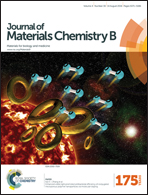Mesoporous carbon nanoparticles capped with polyacrylic acid as drug carrier for bi-trigger continuous drug release†
Abstract
A pH and redox responsive bi-trigger continuous drug release nanocarrier is developed by capping mesoporous carbon nanoparticles (MCNs) with polyacrylic acid (PAA), termed as PAA-ss-MCN. The nanocarrier contains disulfide bond units and exhibits pH responsive behavior. It provides promising potential for drug loading due to the internal uniform channels and large surface area of MCNs. PAA grafted on the exterior surface of MCNs acts as a gating layer, generating a novel nano-container and a pH-responsive intelligent nanovalve. By loading doxorubicin (DOX) in PAA-ss-MCN, its sequential release is achieved via two approaches: (1) the intracellular acidic environment induces partial release from the surface of the PAA gating layer, (2) release of the drug sealed in nanochannels via disruption of the integrity of the nanocarrier by glutathione (GSH) caused dissociation of disulfide bonds in the physiological environment. As a result, release of 62% loaded drug is readily achieved. After culturing with HeLa cells, DOX transports into the cell interior and therein exhibits pH- and GSH-sensitive release. As most tumor sites exhibit more acidic environments or high redox potential, the pH- and GSH-sensitive releasing capability of PAA-ss-MCN is particularly useful for controllable drug delivery by taking advantage of the inherent characteristics of tumor cells.


 Please wait while we load your content...
Please wait while we load your content...